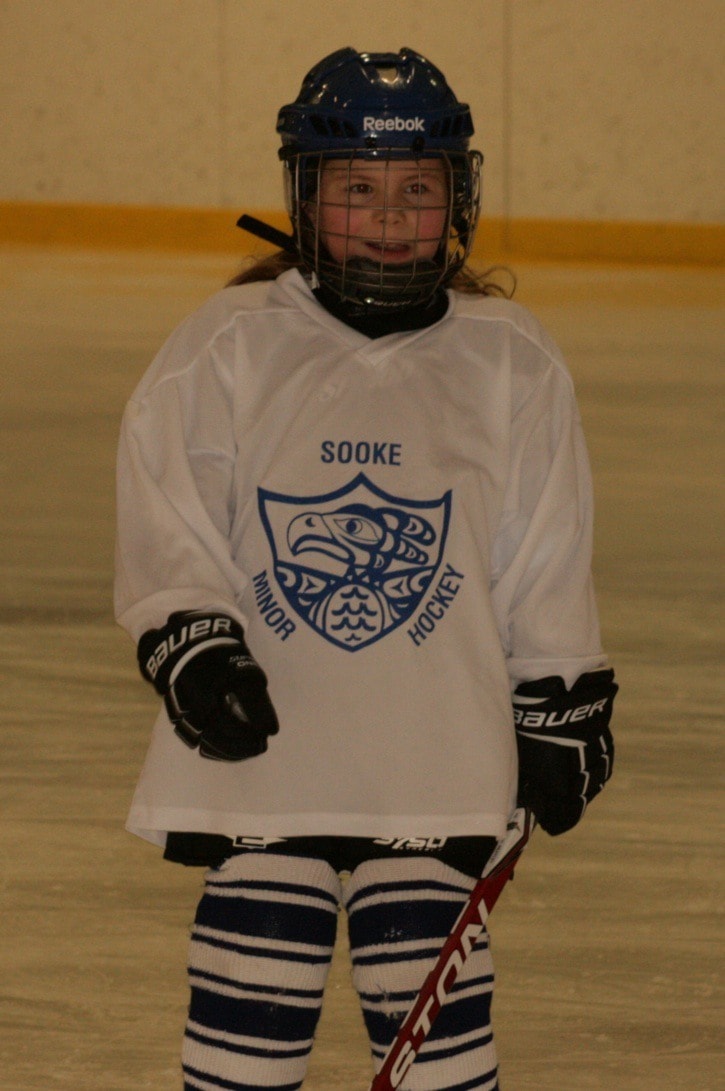Organized minor hockey is steadily growing in Canada. According to BC Hockey (formerly British Columbia Amateur Hockey Association, or BCAHA), the BC hockey involves “approximately 150 minor hockey associations, 4,500 referees, 20,000 official volunteers, and 55,000 players.” (bchockey.net)
Not included in the official volunteer count are the parents who get up in the wee hours of the morning and, with sleep-filled bleary weekend eyes, chauffeur their kids to countless practices, games and tournaments.
Earlier this month, the Dodge Caravan Kids, Novice 2 A, played an early game against their coaches with ice time starting at 8:30 a.m. The sides seem equally balanced: all of the novice players playing against the four coaches. Action raced up and down the ice as the puck steadily shifted between the two goalies.
At this game, the Sooke News Mirror had an opportunity to speak with Laura Kingcott. Kingcott, mother to eight-year-old Samantha, currently on the ice. I asked her what it was like to be a hockey mom.
At this level, Kingcott said, it was pretty easy. “Adults are usually well behaved at this level,” she said, with the emphasis on the word “usually.” She also added that the coaches and managers were all volunteers. Dedication comes from all parties involved, from the players to the parents to the coaches and managers.
She noted that at the novice level, there are typically only two practices a week. Ice time is usually early in the morning, which isn’t that great, but the trade off is that there isn’t a lot of traveling. Sometimes, they go as far as Mill Bay, just over the Malahat.
Kingcott knows the range of commitment involved at all levels, from Novice to Midget. She also has an older daughter, 18-year-old Krista, who has played through the ranks, beginning in Victoria and growing up the ranks in Sooke. At the higher levels, Kingcott says, you can have five to seven practices and games in a week, with games as far away as Port Alberni. That gets more hectic.
Another hockey mom, Jill Phipps, echoed the hectic pace involved at higher levels of hockey, PeeWee and Atom. Besides working full time running her business and overseeing the school responsibilities of her children, Phipps often negotiates more than six ice times per week. Husband and father Al Phipps is also involved in coaching for both boys.
Jill Phipps says that, as a hockey-focussed family, there are financial considerations as well as social one.
“I wouldn’t necessarily call them hardships but hockey can be expensive with gear, travel, camps, etc. For us, we’ve had to make a choice to do hockey and take a pass on other things. Tournaments are often scheduled during school breaks so family vacations usually involve hockey rinks.”
Kathlyn McHugh, the third hockey mom we contacted, agrees. McHugh has two of her three children involved in hockey.
“I am juggling full time work, three kids in other activities including music and dance, as well as trying to have a personal life.”
McHugh affirms the high level of commitment required: “6 a.m. practises, lots of money spent on travelling on weekends and holidays (which means no actual holidays). All our vacation money goes to hockey.”
There are also the parental emotional highs and lows to contend with. It’s hard watching violence happen on the ice, especially when it involves your own child. And it’s hard watching your kids give everything they have only to lose a game, or even worse, be eliminated from a tournament said Hughes.
But as hectic as the scheduling can be in the older levels, the rewards are high. All three moms, however, celebrate the up-side. “We do it,” Kingcott says, “because the kids love it. They learn the team mentality, to give it their all because their team is depending on them, and they make really good friendships.”
Phipps sees the upside of having her children engaged with wholesome and healthy activities.
“The kids have made great friends, learned good sportsmanship and how to be part of a team. They are both very physically active which I hope develops into a lifelong commitment to respect their bodies.” And McHugh has seen tremendous benefit for her kids as well, “Both kids have a solid sense of self and capability. As parents we have a community and social network. Watching your kids develop in a sport is exciting...and there is a a larger sense of being ‘a part of something’ that cannot be duplicated.”
As another mother recently reminded Phipps when she was “complaining about dashing off to the arena for the second time in one day: ‘Well Jill, you could be picking them up at the mall!’”
Saturday’s Novice game against their coaches was a good game. Young Samantha could not stop smiling, and proudly motioned to her mother as she skated speed-style around in circles on the ice at warm up. Success on the ice is ultimately measured by external smiles and inward personal growth, not the number of goals scored or games won. And the smiles gleaming from the Novice kids’ bright faces made the inside of the arena as sunny as the day was outside on that particular Saturday morning.
